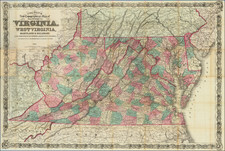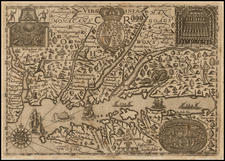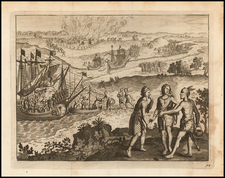Colonial Conflicts Between Virginia Natives and the English
Fine early engraving of the view showing an interaction between English colonists and a contingent of Powhatan tribesmen along the Virginia Coastline.
The image is a later version of the engraving of the "Abduction of Pocahontas", published in Frankfurt by Theodore De Bry for his series of travelogues Grand Voyages. The engraving depicts the encounter between Pocahontas (then a captive of the English) and her father, during the first Anglo-Powhatan war in 1614.
Pocahontas's capture occurred in the context of the First Anglo-Powhatan War, a conflict between the Jamestown settlers and the Native Americans that began late in the summer of 1609. In the first years of war, the English took control of the James River, both at its mouth and at the falls. Captain Samuel Argall, in the meantime, pursued contacts with Native American groups in the northern portion of Powhatan's paramount chiefdom. The Patawomecks, who lived on the Potomac River, were not always loyal to Powhatan and living with them was a young English interpreter named Henry Spelman. In March 1613, Argall learned that Pocahontas was visiting the Patawomeck village of Passapatanzy.
With Spelman's help translating, Argall pressured the villagers to assist in Pocahontas's capture by promising an alliance with the English against the Powhatans. They tricked Pocahontas into boarding Argall's ship and held her for ransom, demanding the release of English prisoners held by her father, along with various stolen weapons and tools. Powhatan returned the prisoners but failed to satisfy the colonists with the number of weapons and tools he returned. A long standoff ensued, during which the English kept Pocahontas captive.
During the year-long wait she was held at Henricus, in modern-day Chesterfield County, Virginia. Little is known about her life there, although colonist Ralph Hamor wrote that she received "extraordinary courteous usage".
In March 1614, the standoff built up to a violent confrontation between hundreds of English and Powhatan men on the Pamunkey River. At Powhatan's capital of Matchcot, the English encountered a group of some senior Native American leaders (but not Powhatan himself, who was away). The English permitted Pocahontas to talk to her countrymen. Pocahontas reportedly rebuked her father for valuing her "less than old swords, pieces, or axes" and told the Powhatan she preferred to live with the English.










![(Mexican-Aztec Paintings) [Aztec Deities from the Codex Laud] Laud MSS (page 3). B65 nunc 678. Aglio 2 Vol.](https://storage.googleapis.com/raremaps/img/small/102323.jpg)
![[ The Dying Bubble-Lord in the Lap of Madame Compagnie ] De stervende Bubbel-Heer in den schoot van Madame Compagne](https://storage.googleapis.com/raremaps/img/small/104094.jpg)

![[Richmond, Virginia Imprint] Map of the State of Virginia Containing The Counties, Principal Towns, Railroads, Rivers, Canals & All Other Internal Improvements. Published by West & Johnston. Richmond Va. 1862 . . .](https://storage.googleapis.com/raremaps/img/small/35235.jpg)
